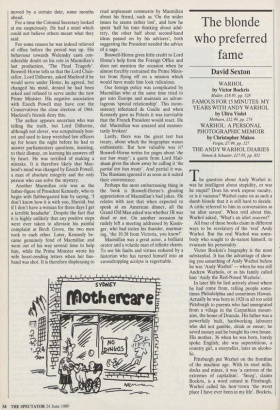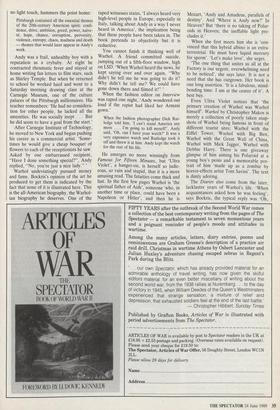The blonde who preferred fame
David Sexton
WARHOL by Victor Bockris
Muller, £18.95. pp. 528
FAMOUS FOR 15 MINUTES: MY YEARS WITH ANDY WARHOL by Ultra Violet
Methuen, £12.99, pp. 274
WARHOL: A PERSONAL PHOTOGRAPHIC MEMOIR by Christopher Makos
Virgin, £7.99, pp. 127
THE ANDY WARHOL DIARIES
Simon & Schuster, £17.95, pp. 832
The question about Andy Warhol is: was he intelligent about stupidity, or was he stupid? Does his work expose vacuity, or is it vacuous? Warhol came on as such a dumb blonde that it is still hard to decide. A critic referred to him in conversation as `an idiot savant'. When told about this, Warhol asked, 'What's an idiot souvent?'
All four of these books claim in different ways to be revelatory of the 'real' Andy Warhol. But the real Warhol was some- body who sought to de-nature himself, to evacuate his personality.
Victor Bockris's biography is the most substantial. It has the advantage of show- ing you something of Andy Warhol before he was 'Andy Warhol' — when he was still Andrew Warhola, or as his family called him 'Andy the Red-Nosed Warhola'.
In later life he lied actively about where he had come from, telling people some- times Philadelphia and sometimes Hawaii. Actually he was born in 1928 in all too solid Pittsburgh to parents who had immigrated from a village in the Carpathian mount- ains, the home of Dracula. His father was a powerfully built, hardworking labourer who did not gamble, drink or swear; he saved money and he bought his own house. His mother, 36 when he was born, barely spoke English; she was superstitious, a country girl, a storyteller, later an alcoho- lic.
Pittsburgh put Warhol on the frontline of the machine age. With its steel mills, docks and mines, it was 'a cartoon of the extremes of capitalism'. 'Smog', claims Bockris, is a word coined in Pittsburgh. Warhol called his hoar town 'the worst place I have ever been in my life'. Bockris, no light touch, hammers the point home:
Pittsburgh contained all the essential themes of the 20th-century American spirit: confi- dence, drive, ambition, greed, power, naive- té, hope, chance, corruption, perversity, violence, entropy, chaos, madness and death — themes that would later appear in Andy's work.
Andy was a frail, unhealthy boy with a reputation as a crybaby. At eight he contracted rheumatic fever and stayed at home writing fan letters to film stars, such as Shirley Temple. But when he returned to school he worked hard and went to a Saturday morning drawing class at the Carnegie Museum, one of the culture palaces of the Pittsburgh millionaires. His teacher remembers: 'He had no considera- tion for other people, he lacked all the amenities. He was socially inept . . . But he did seem to have a goal from the start.'
After Carnegie Institute of Technology, he moved to New York and began pushing his career as a commercial artist. 'Some- times he would give a cheap bouquet of flowers to each of the receptionists he saw. Asked by one embarrassed recipient, "Have I done something special?", Andy replied, "No, you're just a nice lady." ' Warhol undeviatingly pursued money and fame. Bockris's opinion of the art he produced to get them is indicated by the fact that none of it is illustrated here. This is the all-American biography, the Warhol- ian biography he deserves. One of the taped witnesses states, 'I always heard very high-level people in Europe, especially in Italy, talking about Andy in a way I never heard in America', the implication being that these people have been taken in. The book pretends to objectivity but it is reductive.
You cannot finish it thinking well of Warhol. A friend committed suicide, jumping out of a fifth-floor window, high on LSD. 'When Warhol heard the news, he kept saying over and over again, "Why didn't he tell me he was going to do it? Why didn't he tell me? We could have gone down there and filmed it!" ' When the fashion editor on Interview was raped one night, 'Andy wondered out loud if the rapist had liked her Armani gown.'
When the fashion photographer Dick Rut- ledge told him, 'I can't stand America any more . . . I'm going to kill myself!', Andy said, 'Oh, can I have your watch?' It was a very expensive watch and Rutledge took it off and threw it at him. Andy kept the watch for the rest of his life.
He emerges no more winningly from Famous for Fifteen Minutes, but 'Ultra Violet', a hanger-on, is herself so ludic- rous, so vain and stupid, that it is a more amusing read. The fatuities come thick and fast. In the first few pages Warhol is 'the spiritual father of Aids', someone 'who, in another time or place, could have been a Napoleon or Hitler', and then he is Mozart, 'Andy and Amadeus, parallels of destiny'. And 'Where is Andy now?' In Heaven? But 'there is no taking of Polar- oids in Heaven; the ineffable light pre- cludes it.'
When she first meets him she is 'con- vinced that this hybrid albino is an extra- terrestrial. He must have liquid mercury for sperm'. 'Let's make love', she urges.
'The one thing that unites us all at the Factory is our urgent, overwhelming need to be noticed', she says later. It is not a need that she has outgrown. Her book is one long assertion. 'It is a fabulous, mind- bending time. I am at the center of it'. A best buy.
Even Ultra Violet notices that 'the primary creation of Warhol was Warhol himself. Warhol by Christopher Makos is merely a collection of poorly taken snap- shots of Warhol being famous in front of different tourist sites: Warhol with the Eiffel Tower, Warhol with Big Ben, Warhol with the Great Wall of China, Warhol with Mick Jagger, Warhol with Debbie Harry. There is one giveaway glimpse of him aiming his Polaroid at a young boy's penis and a memorable por- trait of him 'made up as a zombie by horror-effects artist Tom Savini'. The text is dimly adoring.
The Diaries also come from the later, lacklustre years of Warhol's life. 'When acquaintances asked how he was feeling', says Bockris, the typical reply was 'Oh, everything's boring.' When they asked about his painting, Andy would say it was 'terrible'. When he went to private screen- ings he would usually fall asleep . . (Bockris). These 800-odd pages faithfully transmit the mood.
And the diaries are not even diaries but transcriptions of telephone conversations Warhol had with a friend to record his expenditure for tax purposes. It makes cabbing seem the passion of his life. And the juxtapositions are absurd: 'Oh, I don't know, I guess I've missed out on a lot in life . . I feel life has passed me by (phone calls $2).'
The general tone is that of Gentlemen Prefer Blondes without the artistic control: no plot, no shaping. Nothing of interest is said about art — the obsessive interests are weight loss and cock size. In a clever marketing move, no index has been pro- vided. Most people will only read this to find Warhol bitching about particular indi- viduals and one is thus prevented from doing that in a bookshop. And it would be a shame to miss, for example, Jerry Hall's deep Philosophy of How to Keep a Man:
'Even if you only have two seconds, drop everything and give him a blow job. That way he won't really want sex with anyone else'.And then she said, 'I know I can tell
that to you (laughs) because you won't tell
anybody.' She's so funny, she says such stupid things.
But there is a highlight. One entry exceeds even those unforgivable remarks recorded by Bockris:
The big news for the past two days is the mass suicide in Guyana of a cult led by somebody named Jim Jones . . They'd put cyanide in grape-flavoured Kool-Aid. (Laughs). Just think, if they'd used Camp- bell's Soup I'd be so famous. I'd be on every news show, everyone would be asking me about it. But Kool-Aid was always a hippie thing.
And there is an anecdote that will stand as the epitaph of junk modernism.
We had breakfast with Joseph Beuys . . . he gave me a work of art which was two bottles of effervescent water which ended up ex- ploding in my suitcase and damaging every- thing I have, so I can't open the box now because I don't know if it's a work of art any more or just broken bottles. So if he comes to New York I've got to get him to come sign the box because it's just real muck.
That's about what these books, taken together, leave you thinking of Andy Warhol. To turn back to his paintings from the early Sixties and his amusing thoughts in From A to B and Back Again is to be startled by his one-time cogency. From A to B is full of humour ('Buying is so much more American than thinking and I'm as American as they come') and good advice of the kind Cosmopolitan should contain but doesn't (' "Aura" must be until you open your mouth'; 'Empty space is never- wasted space'). At his best Andy Warhol was nearly as good as Quentin Crisp, let's not forget.












































































 Previous page
Previous page